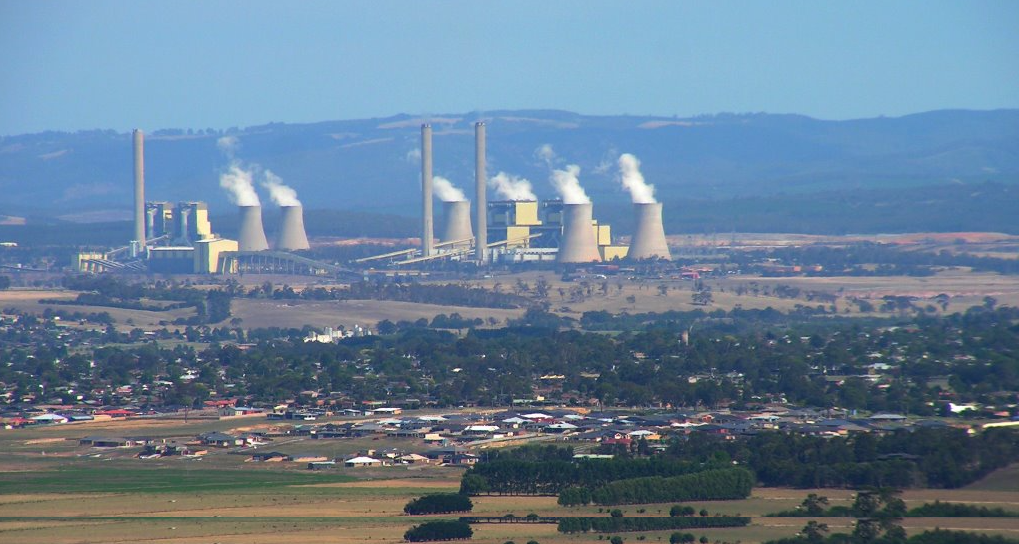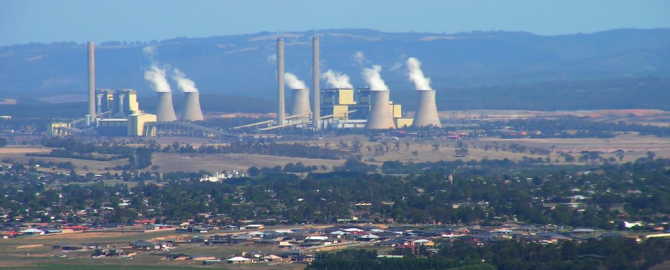
Latrobe Valley is home to three major coal fired power stations, and the open cut coal mines that feed them. To decarbonise the Australian economy requires a substantial transition away from this energy source to renewables.
Such a transition is expected to be disruptive to the economy of the Valley, and many argue that public investment in regeneration and renewable energy programs can help the Valley adapt and thrive. One unresolved question is whether this type of program can be “self-funded” by the economic gains to the region, by directing a share of land value gains that may arise because of improved environmental amenity towards new investments.
Evidence suggests that power plants reduce nearby home values by 3-7%[1], while renewable energy facilities such as wind turbines, have no statistically measurable effect[2]. In a transition period that would include the closure of the three main power plants in the Valley, one could reasonably expect home prices to increase by this amount, subject to sufficient alternative local industrial activity supporting employment in the area. This last point is important, because local wages and employment opportunities are another key determinant of home prices.
It may therefore be possible for a government seeking to spend money on investing in alternative energy facilities, and rehabilitating mine and power station sties, to recoup some of that spending through a charge on land value gains in the local area.
Before pursuing such an approach some estimate of the potential size land value gains is needed. This can then be compared to the costs of the investments needed to close the power stations while maintaining local industry and employment.
The simplest way to do this is to focus on residential land values, which make up the bulk of land values in urban areas, and are most affected by the negative amenity of nearby power plants. The table below shows the calculation of the total value of residential dwellings in the major towns of Latrobe Valley, and then the potential value gains from the closure of the power plants.
The first column is the 2015 median home sale price, with the next the 2011 population (a conservative estimate compared to today’s population). The third column takes the occupancy rate of 2.6 persons per dwelling from the ABS survey of housing to estimate the number of homes from the population, which is immediately multiplied by the median price in each area to get an estimate of the total value of housing in each town.
| Residential Values (2015) | Population (2011) | Est. value @2.6 per home | 3% gain | 7% gain | |
| Moe | 168,000 | 8,751 | 565,449,231 | 16,963,477 | 39,581,446 |
| Morwell | 165,000 | 14,005 | 888,778,846 | 26,663,365 | 62,214,519 |
| Traralgon East | 298,000 | 1,864 | 213,643,077 | 6,409,292 | 14,955,015 |
| Traralgon | 385,000 | 23,834 | 3,529,265,385 | 105,877,962 | 247,048,577 |
| TOTAL | 48,454 | 5,197,136,538 | 155,914,096 | 363,799,558 |
Sources: Land values from Victorian Property Sales Report, Department of Transport, Planning and Local Infrastructure. Population from ABS 2011 Census. Occupancy rate from ABS 4130.0 Housing Occupancy and Costs 2013-2014.
The last two columns are estimates of the value changes that would arise in the two scenarios where the closure of the power plants resulted either a 3% or 7% increase residential home values. The last row is the total for the area, showing that if sufficient employment opportunities are maintained in the area, the net effect on land values of simply closing the power stations and replacing the energy with renewable sources, would be between $155 – $363 million.
At a 5% capitalisation rate, an incremental land value charge that captured all these gains would generate annual revenues of $7 – $18 million from residential landowners.
There are some other points to briefly clarify about this analysis.
- This “back of the envelope” calculation excludes non-residential land uses, which would increase the total gains.
- It excludes any population changes in the past five years, as well as excluding the land value gains in land able to be converted to future residential uses.
- It assumes that all other factors affecting home prices are unchanged. In particular, this means that local wages are sustained because of substantial other investments occurring in the region.
- It ignores cyclical effects on land values that may happen during any transition period.
Lastly, if such a scheme were to be implemented, questions about the distribution of economic gains must also be addressed. In the absence of a land value capture scheme, land value gains would go to a large share of residents with a long term interest in staying in the area, which they may be able to draw on by borrowing to help their own transition and invest in their local businesses. Therefore, a land value capture mechanism is likely to crowd out some private investment that would be facilitated any increase in home prices.
Overall, this exercise gives a reasonable picture of the potential size of land value gains in the areas, which could form a part of any funding arrangement for transitional investment in the region.
[1] Davis, L. W. (2011). The effect of power plants on local housing values and rents. Review of Economics and Statistics, 93(4), 1391-1402.
[2] Lang, C., Opaluch, J. J., & Sfinarolakis, G. (2014). The windy city: Property value impacts of wind turbines in an urban setting. Energy Economics, 44, 413-421.
By Dr Cameron Murray (@rumplestatskin)


Clearly you have never really spent any serious time in Latrobe Valley to understand the real issue.
A $1-2 levy on all electricity bills in the state for a relevant period of time, would be a much fairer way to share the costs involved. Especially when it’s the state that has benefited from Latrobe Valley’s brown coal for 100 years.
Why slug those who have already done the heavy lifting for the prosperity of others…
@ A. Wasiukiewicz, I would be interested in your view on what the real issue us exactly. I haven’t spent a lot of time there, so this is a simple exercise by an objective outside party.
Surely the question should be asked about the potential size and distribution of any gains that arise during a transition away from coal power. There is no silver bullet solution, and I don’t claim that land values are that. But if you want to argue about the distribution of the burden of costs to make a transition, you must understand the distribution of gains.
While your maths could be argued as accurate, you fail to see the error in your assumptions: Prices are already devalued. Ie. They are lower than they should be because of industry that has grown and expanded at the fate of the existing property owner.
Ma and Pa kettle have been hindered in their property price growth, by an industry that has grown in size massively.
If we use another example, by your logic you suggest that because someone bought a home 30 years ago near an airport, and that airport massively expaned affecting their capital gains, that when the airport is demolished and returned to farmland, you suggest it would be appropriate to levy them for gains that they would otherwise already have had naturally if they weren’t inadvertently hindered by the airport.
You are taxing them on growth they were already robbed of.
We can use a further example whereby after privatisation, house prices plummeted to well below the $50k mark. that same home today would sell for $150k.
So while one homeowner lost upwards of $100k (in today’s dollars), the next one gained it back.
Should we have taxed the second home owner because he made a profit after the previous owner made a loss because of privatisation?
Who compensates the first home owner?
Historically? No one. They got rightly screwed.
But the real answer is everyone in the state who benefited by some bloke who had to dig coal, shovel coal, clean a turbine, or burn coal to provide the state with cheap power for ~100 years.
All those people who’s property’s price were subsequently held back should not be penalised once again for being taxed on gains that they otherwise could have had.
So who pays? The state who has benefited off of some poor family’s back.
And that is why a statewide levy on everyone’s electricity bill is the only fair way.
I see your argument now. I don’t think there is a “correct” counterfactual here. The world is a messy place. Property ownership is risky, and windfall gains come to many owners from favourable government investment. Sometimes there are unexpected losses, such as when a new highway comes right by your home.
In any case, who pays is really a moral question we should answer as a society.
Also, as I noted, ensuring local home owner get the gains might provide some local benefits anyway, so taxing them away will crowd out the beneficial local investment they would make.
It will be reasonable to expect that as power station closures occur, local property values will further decline and will take some years to increase. In the case of the mid-1990s corporatisation, there was no economic adjustment support provided at all at the time by the LNP Government of the day. The region’s economy went into freefall with the loss of about 7000 jobs and took more than a decade to achieve a steady state recovery. There have been a number of new industries established since that time and the region’s largest sector is now services, although the electricity industry and the allied engineering support is still substantial.
Parts of the Latrobe Valley such as Moe and Morwell have never economically recovered from the 1990s and are still characterised by some of the highest levels of unemployment, youth disengagement and family violence in the country. The Latrobe Valley has historically never enjoyed high levels of government infrastructure investment and still contains areas of urban decay and debilitating landscapes.
It would seem very unfair to consider taxing land profits when properties are generally (with the exception of Traralgon), well below those in comparable cities like Ballarat and Bendigo. The area desparately needs major investment in removing life expired retail areas, substantial urban renewal and a smart investment attraction strategy to attract inbound private and public sector entities. The building blocks are basically there…proximity to Melbourne, nearby national parks and coast, cheap industrial land, all services and generally good transport infrastructure – although the railway connection is hampered by metropolitan congestion.
Taxing nominal and probably long term property gains is quite unfair when it should be remembered that cheap coal fired power has propped up the State economy for generations. Now is the time to start remembering what the Latrobe Valley has endured for those elsewhere.